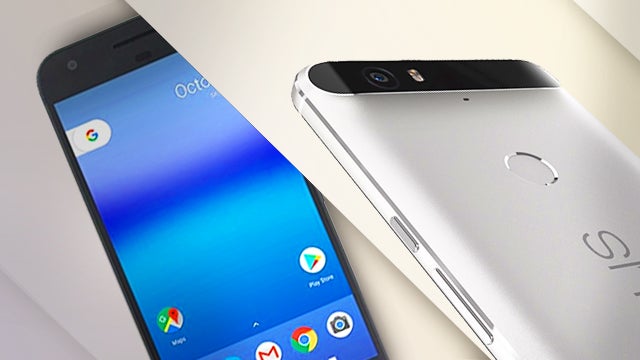Google Pixel vs Nexus 6P: What’s the difference?

Google Pixel vs Nexus 6P: Is it worth an upgrade? We take a look with our in-depth comparison.
The Nexus 6P was the finest phone to feature the Nexus branding, and it also appears to be the last. This year, we say hello to Pixel – two new phones from Google that will take the fight directly to Samsung and Apple.
The Pixel and Pixel XL are high-powered, expensive handsets that look great on paper. But how do they compare to the five-star Nexus 6P? Let’s take a look.
Watch: Google’s Pixel phone event in just 3 minutes
Google Pixel vs Nexus 6P – Design
Built by Huawei, the Nexus 6P was big and beautiful. A sleek metal slab, it had chamfered edges and a black visor snaking across the top of the back. It was tough to hold in one hand, but it looked cool – in a futuristic sort of way.
The Pixel isn’t quite as eye-catching, taking a more restrained approach with a flat rear and rounded corners. It looks a little like an iPhone – a tired design itself – and HTC’s One A9. It isn’t ugly; it’s just a bit dull. With plenty of metal and glass, it feels good though.
Related: Pixel vs Pixel XL
![]()
The larger Pixel, the XL, is a better comparison with a Nexus 6P. They’re both phablet-sized, but the XL is smaller in just about every way. It’s easier to hold too, with the 6P often feeling ungainly. If you’d prefer something smaller still, which doesn’t sacrifice performance or features, there’s the Pixel.
Google Pixel vs Nexus 6P – Display
Both the Pixel and Nexus 6P feature excellent screens. At the larger end, the 5.7-inch QHD AMOLED panel on the Nexus 6P took the phone straight into phablet territory. Google has opted for the more popular 5.5-inch size for the Pixel XL, however. It’s still an AMOLED 2,560 x 1,440 resolution screen though, and looks great. Blacks are deep and colours are rich on both screens, each displaying plenty of detail.
The Pixel drops the resolution down to 1080p, but since it has a smaller 5-inch display, the difference – on first look, anyway – appears to be minimal. FHD at 5-inches is fine, with pixels tough to pick out and colours still nice and rich.
Related: Pixel vs iPhone 7
![]()
Google Pixel vs Nexus 6P – Performance and Software
Whether it’s a Nexus or a Pixel, Google’s phones have always been powerful handsets.
The Nexus 6P was one of the last phones to use the ill-fated Snapdragon 810 – which performed perfectly well here – while also packing 3GB of RAM and a choice between 32GB, 64GB, or 128GB of internal storage.
For the Pixel and Pixel XL, Google has upped the ante in every area. Powering the duo is Snapdragon’s shiny 821 CPU and 4GB of RAM. This new CPU hasn’t been used yet, so it will be interesting to see how it fares. We’re not expecting a huge jump over the 820, but it does have a higher clock speed.
Google is also thinning out the storage options, leaving potential buyers with a choice of either 32GB or 128GB. Pick wisely, since there’s no expandable storage here.
Related: Galaxy S7 vs Google Pixel

As is typical with a phone direct from Google, the software is how Google intends Android to be. The Pixel phones now come with the Pixel Launcher which shifts things around on the homescreen a bit and freshens up the icons. Both phones are on Android 7, and will be updated quickly to the upcoming versions.
You can expect to run Google’s new Daydream VR on the Pixel phones, too, and both should work with the new Daydream View headset.
Google Pixel vs Nexus 6P – Camera
Cameras on Nexus phones were poor, and then the Nexus 6P came along and righted many of the wrongs. Its 12-megapixel snapper featured an addictive slow-motion mode and a number of tricks that helped it stand out.
Specs-wise, the camera on the Pixel phone is a 12.3-megapixel unit with an f/2.0 aperture, while the secondary, front-facing camera captures 8-megapixel selfies.
Both can record 4K video at 30fps, and both are stuck with Google’s slightly restrictive camera app.
Related: Google Pixel phone launch

Google Pixel vs Nexus 6P – Battery
Both the Pixel XL and Nexus 6P feature the same battery. The 3,450mAh cell is charged via a USB Type-C port that can be found on the bottom of each device.
The Nexus 6P had great stamina, and easily made it through one day and into the next. Since it has a smaller display, we expect the Pixel XL to last longer.
The regular Pixel has a 2,770mAh battery, noticeably smaller and the same size as the Nexus 5X. We’ll have to test it out further to see how it performs over a day, but it also comes with a USB Type-C port and fast charging.
Buy Now: Nexus 6P at Amazon.com from $449
Google Pixel vs Nexus 6P – Price and release
The Pixel phone is available to pre-order now in the US and UK. The Pixel will be £599 (32GB) and £699 (128GB) with the Pixel XL coming in at £719 (32 GB) and £819 (128GB). The phone will actually release on October 20.
Buy Now: Google Pixel at Amazon.com from $839
First Impressions
The rebranding of the Nexus line to Pixel is perhaps the biggest change here, with a lot of the internal upgrades not particularly significant.
We do like the fact that the Pixel is available in two sizes, but by picking the smaller model you don’t sacrifice performance over features.
We’ll have more once we’ve reviewed both Pixel phones.
Related: Google Pixel vs Note 7
Watch The Refresh: The best tech gossip and reviews every week
Let us know which phone you think comes out on top in the comments.


